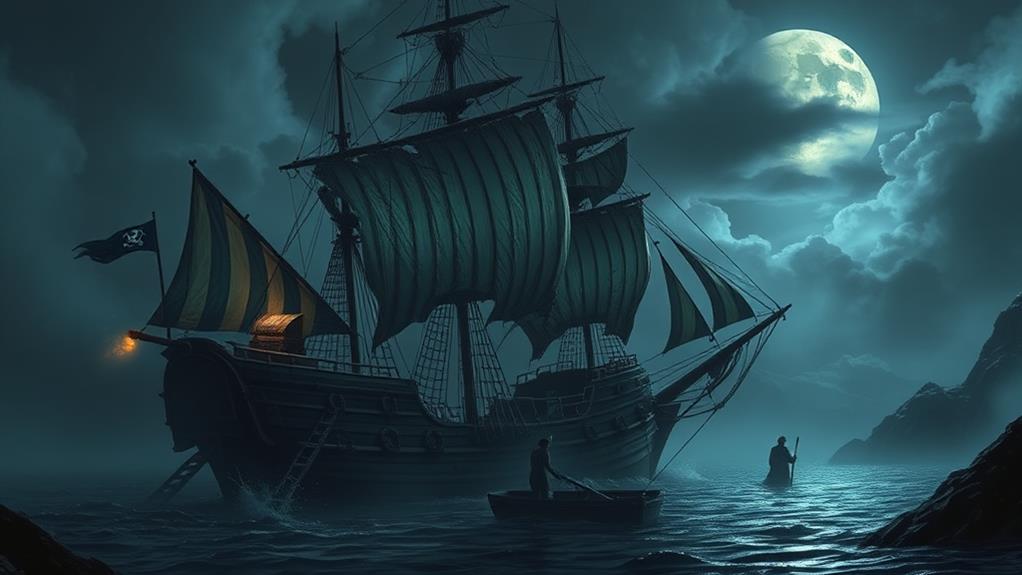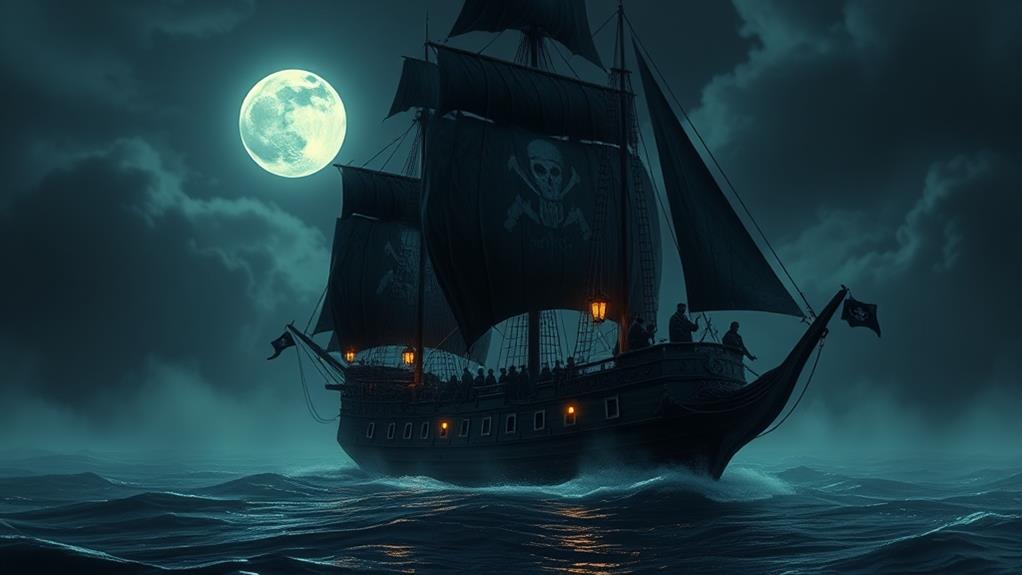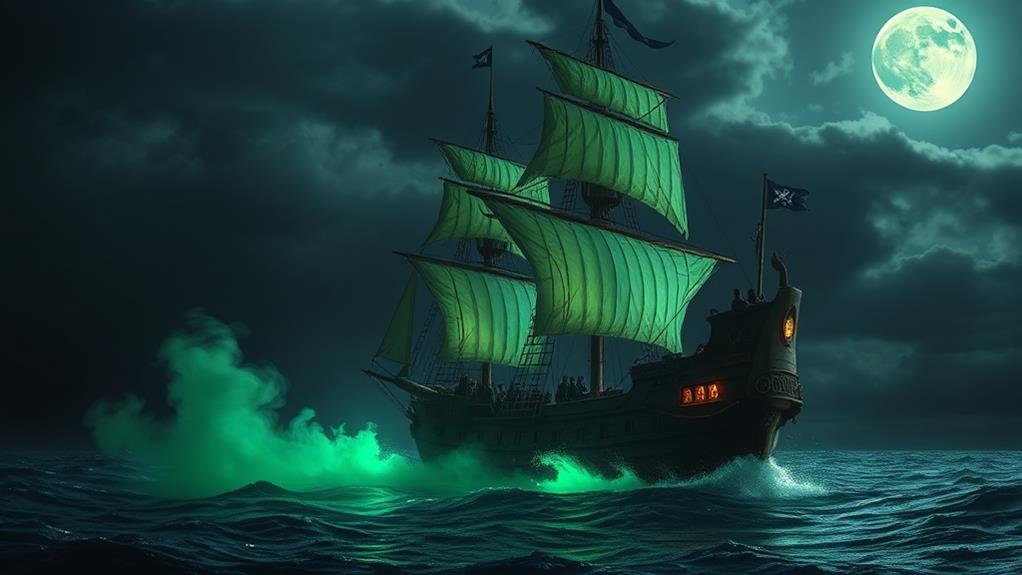
Set sail on an adventure with iconic pirate ships like Blackbeard's Queen Anne's Revenge, renowned for its firepower and fearsome reputation. Imagine the treasures aboard Black Sam Bellamy's Whydah Gally, lost to a violent storm. Feel the supernatural allure of Captain Jack Sparrow's Black Pearl, known for its speed and mystery. Encounter the ruthless efficiency of Black Bart's Royal Fortune, a terror of the high seas. Finally, ponder the legendary curse of the ghostly Flying Dutchman, forever sailing without rest. Each ship carries tales of adventure, power, and a touch of the supernatural, waiting for you to explore their stories.
The Queen Anne's Revenge

When you think of infamous pirate ships, the Queen Anne's Revenge likely springs to mind. Captained by the notorious Blackbeard, this ship's name strikes fear into the hearts of sailors and conjures images of swashbuckling adventures. Originally a French slave ship named La Concorde, Blackbeard captured it in 1717 and transformed it into his flagship.
Onboard, you'd find a formidable array of weaponry, including 40 cannons, making it one of the most powerful pirate ships of its time. Blackbeard's crew, totaling around 300 men, was a fearsome lot, ready to plunder and pillage any vessel they crossed paths with. The Queen Anne's Revenge was involved in several major confrontations, including the blockade of Charleston, South Carolina, in 1718.
Blackbeard's reign of terror didn't last long, though. Later in 1718, the Queen Anne's Revenge ran aground near Beaufort, North Carolina. Some speculate he did this intentionally to downsize his crew. Despite its short-lived career, the Queen Anne's Revenge remains etched in pirate lore, a symbol of the golden age of piracy. When you picture the quintessential pirate ship, it's hard not to see Blackbeard's infamous vessel.
The Whydah Gally
Among the legendary pirate ships, the Whydah Gally stands out for its dramatic story and the treasure it carried. Originally a slave ship, it was captured by the infamous pirate Black Sam Bellamy in 1717. Bellamy turned the Whydah into his flagship, using it to amass a vast fortune from plundered vessels.
But the Whydah's tale took a fateful turn when it encountered a violent storm off the coast of Cape Cod. The ship, weighed down by its loot, succumbed to the fierce weather and sank, taking most of its crew and treasure with it. The Whydah's wreck remained lost for centuries until it was discovered in 1984 by underwater explorer Barry Clifford.
- Treasure Trove: The Whydah carried an estimated four and a half tons of gold, silver, and precious artifacts.
- Historical Significance: It's the only authenticated pirate shipwreck in North America.
- Grim Fate: Of the 146 crew members, only two survived the shipwreck.
The Whydah Gally's story is an enthralling blend of adventure, wealth, and tragedy, making it one of the most fascinating chapters in pirate history.
The Black Pearl

While the Whydah Gally's tale is grounded in historical fact, the Black Pearl sails the seas of legend and popular culture. You can't talk about iconic pirate ships without mentioning this infamous vessel from Disney's "Pirates of the Caribbean" franchise. The Black Pearl, captained by the charismatic and cunning Jack Sparrow, has become a symbol of adventure, freedom, and mystique.
In the films, the Black Pearl is known for its striking black hull and sails, making it a ghostly presence on the ocean. It's not just its appearance that captures your imagination; the Black Pearl is reputed to be the fastest ship in the Caribbean, able to outrun any naval vessel or pursuing pirate. This speed and its near-mythical status are key to its legendary tales.
The ship's lore is steeped in curses and supernatural elements, adding to its allure. Cursed gold, undead crews, and epic sea battles make the Black Pearl a central character in its own right. When you think of the Black Pearl, you're reminded of its endless quest for freedom and the unyielding spirit of piracy that it embodies.
The Royal Fortune
The Royal Fortune, captained by the infamous pirate Black Bart, stands as one of the most feared and legendary pirate ships of the early 18th century. You'd be hard-pressed to find a vessel that struck more terror into the hearts of sailors. Known for its speed and firepower, the Royal Fortune was a formidable force on the high seas.
Imagine you're a merchant sailor, and suddenly, the black flag of Black Bart appears on the horizon. Panic sets in because you know the Royal Fortune's reputation—it rarely leaves survivors. Black Bart, or Bartholomew Roberts, was notorious for his ruthless efficiency and cunning tactics. His ship captured over 400 vessels, making him one of the most successful pirates in history.
To understand the Royal Fortune's impact, consider these key points:
- Speed and Maneuverability: The Royal Fortune could outpace most naval ships, allowing it to chase down targets or evade capture.
- Armament: Equipped with up to 40 cannons, it could unleash a maelstrom of devastating firepower.
- Crew: The ship's crew was fiercely loyal and well-trained, making them a deadly force in naval combat.
The Flying Dutchman

Legends of the high seas wouldn't be complete without the ominous tale of the Flying Dutchman. You've probably heard whispers of this phantom ship, doomed to sail the oceans forever. It's said the Flying Dutchman can never make port, and any ship that encounters it is fated for disaster. The legend originates from the 17th century, when seafaring was fraught with peril and superstition.
The tale goes that Captain Hendrick van der Decken was trying to navigate through a fierce storm near the Cape of Good Hope. In his hubris, he swore to round the cape even if it took him until Judgment Day. The devil took him at his word, condemning him and his crew to an eternal voyage.
You might spot the Flying Dutchman as a ghostly apparition, gliding silently across the waves, glowing with an eerie light. Mariners claim it's a bad omen, a harbinger of doom. Some even believe it's a vessel of lost souls, forever seeking redemption. Whether fact or fiction, the Flying Dutchman's spectral presence has cemented its place in nautical folklore, sending shivers down the spine of any sailor who hears its name.
At a Glance
You've just discovered the tales behind some of history's most iconic pirate ships, like the Queen Anne's Revenge and the Flying Dutchman. Coincidentally, as you finish reading, you might find yourself near a coastal town or planning a seaside trip. Keep an eye out, because who knows? You might stumble upon a hidden relic or hear a local legend that ties you directly to these legendary ships. Adventure awaits, and sometimes, it's closer than you think.






